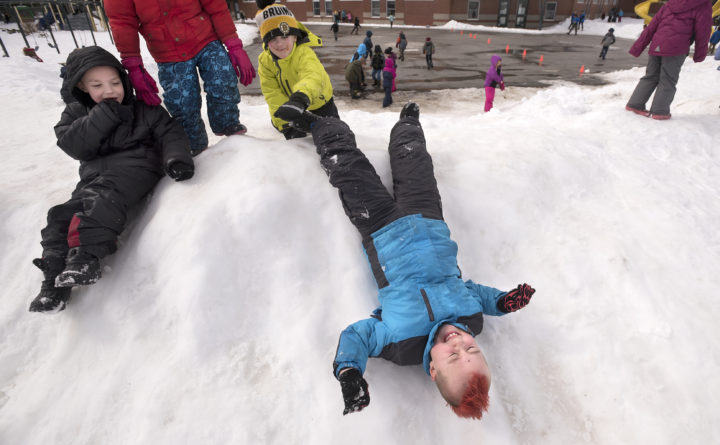
Several weeks ago, Asa Adams Elementary School Principal Darren Akerman had a tough choice to make. The sledding hill by the Orono school was iced over, and students could barely walk without slipping on the icy playground.
Akerman decided to cancel outdoor recess that day. It was simply unsafe to let students play outside.
“They could barely get out and walk,” he said. “In these cases you have to make tough decisions. You don’t want them to get hurt.”
Elementary school principals in the Bangor area agree on the importance of outdoor recess and the benefits the outdoor, unstructured play periods hold for students. But most don’t let students go outside if the temperature feels like it’s below 10 degrees. The schools also don’t typically keep track of how many days of outdoor recess students lose to the cold weather.
That all puts the schools in the Bangor area firmly in the mainstream for Maine, according to a University of Maine researcher who surveyed schools across the state about their outdoor recess policies and practices during the winter months. She was trying to learn the temperature thresholds at which schools cancel outdoor recess and whether the schools keep track of when they cancel the outdoor periods.
“I already knew going into it that schools have varying recess policies, so I wanted to understand where these policies were coming from,” said Lauren Jacobs, a lecturer in kinesiology and physical education at UMaine.
She found a correlation between a school’s geographic location and its temperature threshold: Maine’s northern schools, she found, let students go outside for recess in colder weather compared with their southern counterparts.
In her paper, published in 2017, Jacobs split the state into three climate sections: northern, southern interior and coastal. She found that most northern schools canceled outdoor recess when temperatures dropped below zero, while most coastal schools had higher cutoffs, ranging from 11 to 20 degrees.
Out of the 50 schools she surveyed in the southern interior region — which includes the Bangor area — 33 schools cited 10 degrees as their threshold.
[Subscribe to our free morning newsletter and get the latest headlines in your inbox]
“We want our students to be outside,” said Dan Chadbourne, principal of Bangor’s Fourteenth Street School. “We’ve done things where we’ve reduced the time they spend outside. Bringing them inside is the last resort.”
When Bangor schools cancel outdoor recess, they use classrooms and gym spaces for physical activity. They sometimes use GoNoodle, a website designed to lead kids through movements such as dancing and jumping, to keep students moving.
“We make sure kids are active throughout the indoor recess,” said Principal Richard Fournier of Fruit Street School.
In Old Town, the elementary school takes a similar approach, trying to keep students as active as possible, said Principal Jeanna Tuell.
The school is developing what Tuell called a “sensory hallway” that will feature a series of squares on the floor, each with instructions for an exercise or movement students can do when they step into that square.
“We want them to go out and play,” she said. “We feel like we’re almost doing a disservice to them even though it’s for their safety.”
Extensive research has found that young children learn better when they have unstructured playtime, specifically outdoors.
“Without having outdoor recess, students don’t really perform as well,” said Akerman, Asa Adams Elementary School principal. “They need that break.”
Jacobs said that she believed that Maine winter is not extreme enough to cause students to miss outdoor recess. She said she also believes schools should keep track of how many days students are missing outdoor recess so they can figure out how to reduce the number.
“I’d encourage schools to think of creative solutions,” she said, “ways to overcome those challenges rather than say, ‘We can’t go out.’”
This article originally appeared on www.bangordailynews.com.







